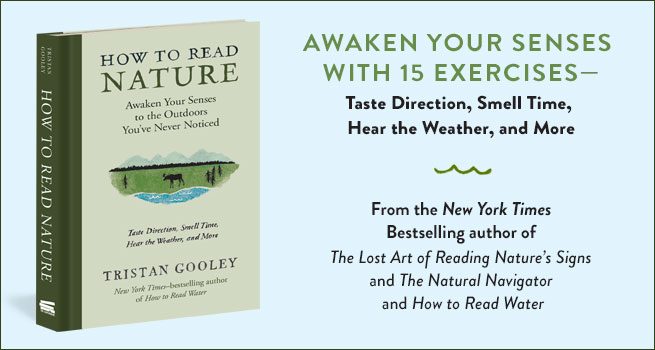The last few years have seen a major cultural shift towards “waking up.” Whatever the reason for the shift, becoming “woke” is now a process, and not the default mode in which we exist. And nowhere is our need to wake greater than in the outdoors. Navigational expert Tristan Gooley has helped readers learn, or relearn, how to tune in to nature’s messages for years. His previous books The Natural Navigator and The Lost Art of Reading Nature’s Signs helped readers relearn the forgotten skill of using nature as a guide. His last book, How to Read Water, helped readers unlock the secrets of the world’s most abundant resource.
Now, with two decades of pioneering outdoor experience under his belt, his newest book, How to Read Nature: Awaken Your Senses to the Outdoors You’ve Never Noticed (The Experiment; October 3, 2017; Paper Over Boards; $16.95; ISBN: 978-1-61519-429-2) will teach us to reawaken our senses in order to help us understand and deepen our personal experience of nature.
In the book, Gooley quotes Ray Bradbury, saying: “Life is trying things to see if they work.” In that spirit, he gives readers 15 exercises to practice reading nature using all five senses. The exercise excerpted below is intended to help readers unlock the full potential of their sight.
by Tristan Gooley
Part I
Go for a three-minute walk outdoors. Note down the things your eyes are drawn toward. If we have an understanding of the things our brain is likely to prioritize, then we can temporarily override this pecking order and we will start to see new things.
Part II
Repeat your three-minute walk following the same route, only this time try to ignore anything that moves, as much as is safely possible. Let your eyes be drawn to things that remain still. Ignore everything that shows any motion at all—people, animals, leaves in a breeze. It should feel a little peculiar and lead to you noticing at least a few things that you overlooked on your first walk.
Our brains have learned to notice things that move, so if we make a special effort to look for things that are still, we see a subtly different world.
What is the broader lesson? I think that a focused interest is a two-edged sword: It allows us to notice many things that pass others by, but it narrows the spotlight of our vision. A keen passion for one area of nature will definitely encourage you to spot many things, but not everything. To use both edges of this sword in a positive way, we need to develop our interests but then remain conscious of the blind spots these might introduce.



